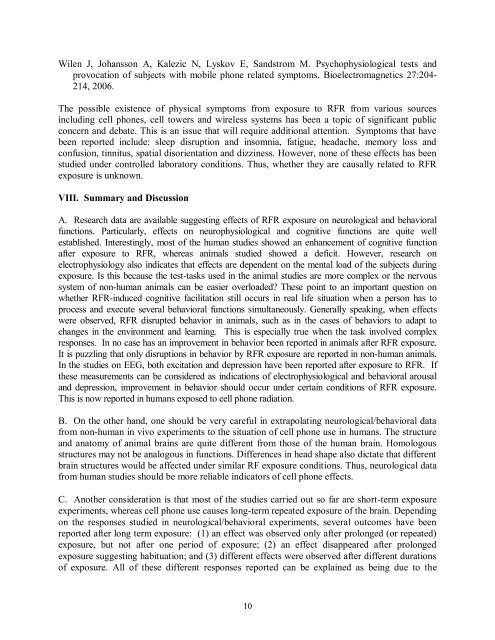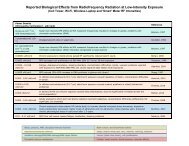Evidence for Effects on Neurology and Behavior - BioInitiative Report
Evidence for Effects on Neurology and Behavior - BioInitiative Report
Evidence for Effects on Neurology and Behavior - BioInitiative Report
Create successful ePaper yourself
Turn your PDF publications into a flip-book with our unique Google optimized e-Paper software.
Wilen J, Johanss<strong>on</strong> A, Kalezic N, Lyskov E, S<strong>and</strong>strom M. Psychophysiological tests <strong>and</strong><br />
provocati<strong>on</strong> of subjects with mobile ph<strong>on</strong>e related symptoms. Bioelectromagnetics 27:204-<br />
214, 2006.<br />
The possible existence of physical symptoms from exposure to RFR from various sources<br />
including cell ph<strong>on</strong>es, cell towers <strong>and</strong> wireless systems has been a topic of significant public<br />
c<strong>on</strong>cern <strong>and</strong> debate. This is an issue that will require additi<strong>on</strong>al attenti<strong>on</strong>. Symptoms that have<br />
been reported include: sleep disrupti<strong>on</strong> <strong>and</strong> insomnia, fatigue, headache, memory loss <strong>and</strong><br />
c<strong>on</strong>fusi<strong>on</strong>, tinnitus, spatial disorientati<strong>on</strong> <strong>and</strong> dizziness. However, n<strong>on</strong>e of these effects has been<br />
studied under c<strong>on</strong>trolled laboratory c<strong>on</strong>diti<strong>on</strong>s. Thus, whether they are causally related to RFR<br />
exposure is unknown.<br />
VIII. Summary <strong>and</strong> Discussi<strong>on</strong><br />
A. Research data are available suggesting effects of RFR exposure <strong>on</strong> neurological <strong>and</strong> behavioral<br />
functi<strong>on</strong>s. Particularly, effects <strong>on</strong> neurophysiological <strong>and</strong> cognitive functi<strong>on</strong>s are quite well<br />
established. Interestingly, most of the human studies showed an enhancement of cognitive functi<strong>on</strong><br />
after exposure to RFR, whereas animals studied showed a deficit. However, research <strong>on</strong><br />
electrophysiology also indicates that effects are dependent <strong>on</strong> the mental load of the subjects during<br />
exposure. Is this because the test-tasks used in the animal studies are more complex or the nervous<br />
system of n<strong>on</strong>-human animals can be easier overloaded? These point to an important questi<strong>on</strong> <strong>on</strong><br />
whether RFR-induced cognitive facilitati<strong>on</strong> still occurs in real life situati<strong>on</strong> when a pers<strong>on</strong> has to<br />
process <strong>and</strong> execute several behavioral functi<strong>on</strong>s simultaneously. Generally speaking, when effects<br />
were observed, RFR disrupted behavior in animals, such as in the cases of behaviors to adapt to<br />
changes in the envir<strong>on</strong>ment <strong>and</strong> learning. This is especially true when the task involved complex<br />
resp<strong>on</strong>ses. In no case has an improvement in behavior been reported in animals after RFR exposure.<br />
It is puzzling that <strong>on</strong>ly disrupti<strong>on</strong>s in behavior by RFR exposure are reported in n<strong>on</strong>-human animals.<br />
In the studies <strong>on</strong> EEG, both excitati<strong>on</strong> <strong>and</strong> depressi<strong>on</strong> have been reported after exposure to RFR. If<br />
these measurements can be c<strong>on</strong>sidered as indicati<strong>on</strong>s of electrophysiological <strong>and</strong> behavioral arousal<br />
<strong>and</strong> depressi<strong>on</strong>, improvement in behavior should occur under certain c<strong>on</strong>diti<strong>on</strong>s of RFR exposure.<br />
This is now reported in humans exposed to cell ph<strong>on</strong>e radiati<strong>on</strong>.<br />
B. On the other h<strong>and</strong>, <strong>on</strong>e should be very careful in extrapolating neurological/behavioral data<br />
from n<strong>on</strong>-human in vivo experiments to the situati<strong>on</strong> of cell ph<strong>on</strong>e use in humans. The structure<br />
<strong>and</strong> anatomy of animal brains are quite different from those of the human brain. Homologous<br />
structures may not be analogous in functi<strong>on</strong>s. Differences in head shape also dictate that different<br />
brain structures would be affected under similar RF exposure c<strong>on</strong>diti<strong>on</strong>s. Thus, neurological data<br />
from human studies should be more reliable indicators of cell ph<strong>on</strong>e effects.<br />
C. Another c<strong>on</strong>siderati<strong>on</strong> is that most of the studies carried out so far are short-term exposure<br />
experiments, whereas cell ph<strong>on</strong>e use causes l<strong>on</strong>g-term repeated exposure of the brain. Depending<br />
<strong>on</strong> the resp<strong>on</strong>ses studied in neurological/behavioral experiments, several outcomes have been<br />
reported after l<strong>on</strong>g term exposure: (1) an effect was observed <strong>on</strong>ly after prol<strong>on</strong>ged (or repeated)<br />
exposure, but not after <strong>on</strong>e period of exposure; (2) an effect disappeared after prol<strong>on</strong>ged<br />
exposure suggesting habituati<strong>on</strong>; <strong>and</strong> (3) different effects were observed after different durati<strong>on</strong>s<br />
of exposure. All of these different resp<strong>on</strong>ses reported can be explained as being due to the<br />
10



